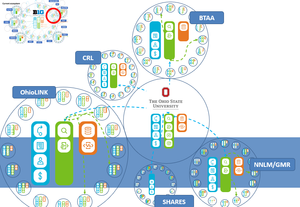I have written about the Audience Level measure in these pages a few times. In this initiative we are using the pattern of holdings across different types of libraries (school, research, etc) to give a ‘hint’ about the level of interest of an item (juvenile, research/specialist, …). You can read more about how we calculate the levels on the project page:
Recognizing that different types of libraries typically serve different populations, OCLC researchers considered whether library types could be related to audience levels. They decided to explore whether the pattern of holdings of materials in WorldCat might be leveraged to provide an audience-level indicator. [Audience Level [OCLC – Projects]]
The audience level is used in Worldcat Identities pages. It is also used in various internal processing activities where data of a certain type is required, for example where we are asked to share data about ‘academic’ materials. Check it out here.
My colleagues carried out an evaluation a while ago to see how closely this algorithmic approach based on holdings patterns matched human judgments. Their results were published in JASIST last year.
Edward T. O’Neill, Lynn Silipigni Connaway, Timothy J. Dickey. Estimating the audience level for library resources. Journal of the American Society for Information Science and Technology. Volume 59, Issue 13, Pages 2042-2050. 2008
[https://dx.doi.org/10.1002/asi.20908 subscription resource]
Update: Pre-print available online at: https://www.oclc.org/research/publications/archive/2008/oneill-jasist.pdf..
The team first examined a randomly generated sample of books from a research library, and the results looked promising. They then proceeded to a more formal test.
The second test compared the rankings of the audience level against ranking decisions made by human subjects. A sample of 30 books was ranked by each of 21 test participants, and a set of test rankings was created for each of the books. The test collection consisted of a stratified sample of 30 books from WorldCat. The books were all in the field of zoology, published in the year 2004, and representative of the entire spectrum of audience-level rankings.
And the result …
The conclusion is that there exists a significant correlation between the human subjects’ ranking and the audience-level rankings. The most important result of this test is the indication that the audience level and human subjects’ perceptions are strongly correlated.
Leading them to conclude ..
The audience level is a valuable aid in identifying the appropriate resources for a particular audience. The algorithm produced audience-level values that were consistent with those of human evaluators as demonstrated both by the analysis of the actual books and by the comparison of the algorithmic results to those of a test group of human subjects. Based on the findings of this research, the audience level can be seen as a new tool with the potential to improve information relevance for discovery and selection for collection analysis, readers’ advisory, and reference services.



